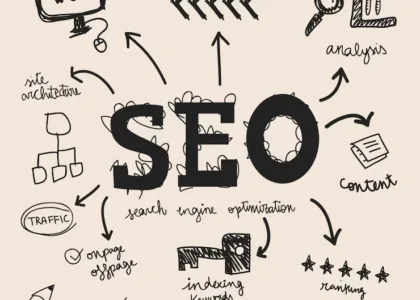In today’s highly competitive online marketplace, staying ahead with the latest SEO strategies for e-commerce is crucial. With search engines constantly evolving and consumer behavior shifting, 2025 brings new opportunities and challenges for online retailers. Whether you’re running a small shop or managing a large online store, optimizing your site for search engines is non-negotiable. Let’s dive into the top 10 SEO strategies that will make your e-commerce site stand out in 2025.
1. Optimize for Voice Search
Voice search is no longer a futuristic concept—it’s here and growing fast. With the rise of smart speakers and voice assistants like Alexa, Siri, and Google Assistant, optimizing your content for voice search is essential. SEO strategies for e-commerce must now focus on conversational keywords and natural language queries.
How to Implement:
- Use long-tail keywords that mimic natural speech.
- Answer common customer questions in your product descriptions and FAQs.
- Optimize for “near me” searches if you have a physical presence.
Pro Tip: Think about how your customers would phrase their queries verbally. For example, instead of “best running shoes,” they might say, “What are the best running shoes for flat feet?”
2. Leverage AI and Machine Learning
AI and machine learning are revolutionizing how search engines rank content. Google’s algorithms are becoming smarter, prioritizing relevance and user experience over traditional keyword stuffing. SEO strategies for e-commerce must adapt by focusing on creating high-quality, engaging content.
How to Implement:
- Use AI tools to analyze user behavior and adjust your content accordingly.
- Implement dynamic content that changes based on user preferences.
- Leverage AI-powered chatbots to improve customer engagement.
External Resource: Check out Google’s AI guidelines to understand how machine learning influences search rankings.
3. Focus on Mobile-First Indexing
With over half of global web traffic coming from mobile devices, Google has officially moved to mobile-first indexing. This means the mobile version of your site is the primary version considered for ranking.
How to Implement:
- Ensure your website is responsive and mobile-friendly.
- Optimize loading speeds using tools like Google PageSpeed Insights.
- Simplify navigation for smaller screens.
Pro Tip: Test your site on various mobile devices to ensure a seamless user experience.
4. Enhance User Experience (UX)
User experience is a significant ranking factor. A website that is easy to navigate, visually appealing, and quick to load will not only retain visitors but also rank higher in search results.
How to Implement:
- Simplify your website’s layout and improve site speed.
- Use clear calls-to-action (CTAs) to guide users.
- Implement intuitive product categories and filters.
Internal Link: For more tips on optimizing your e-commerce site’s UX, visit Ecombizzform.
5. Invest in High-Quality Content
Content is still king in 2025. But it’s not just about quantity; quality matters more than ever. Creating valuable, informative, and engaging content will boost your SEO performance and establish your brand as an authority.
How to Implement:
- Start a blog featuring product reviews, how-to guides, and industry news.
- Use multimedia content like videos, infographics, and podcasts.
- Regularly update old content to keep it relevant.
Pro Tip: Incorporate SEO strategies for e-commerce naturally within your content to improve rankings without sounding forced.
6. Utilize Structured Data and Schema Markup
Structured data helps search engines understand your content better, leading to rich snippets in search results—which can significantly increase your click-through rates.
How to Implement:
- Use schema markup for products, reviews, prices, and availability.
- Implement breadcrumb schema for better site navigation.
- Use tools like Google’s Structured Data Markup Helper to simplify the process.
External Resource: Learn more about schema markup from Schema.org.
7. Prioritize Local SEO
Even if you’re an online-only retailer, local SEO can help you attract nearby customers and build trust. Google My Business (GMB) listings and local citations are essential components of SEO strategies for e-commerce in 2025.
How to Implement:
- Claim and optimize your Google My Business profile.
- Encourage satisfied customers to leave reviews.
- Use location-based keywords in your content.
Pro Tip: Don’t forget to include NAP (Name, Address, Phone number) consistently across your website and directories.
8. Improve Site Speed and Core Web Vitals
Site speed isn’t just a convenience—it’s a ranking factor. Google’s Core Web Vitals focus on loading performance, interactivity, and visual stability, making them essential for SEO strategies for e-commerce.
How to Implement:
- Compress images and use modern formats like WebP.
- Enable browser caching and reduce server response times.
- Use a Content Delivery Network (CDN) to distribute content globally.
Internal Link: Need help optimizing your site speed? Contact the experts at Ecombizzform.
9. Optimize for Visual Search
Visual search technology is becoming increasingly popular, allowing users to search using images instead of text. Platforms like Google Lens are paving the way for this trend, making it a critical component of modern SEO strategies for e-commerce.
How to Implement:
- Use high-quality images with descriptive file names and alt text.
- Implement image sitemaps to help search engines index your visuals.
- Leverage platforms like Pinterest, which prioritizes visual search.
Pro Tip: Make sure your product images are consistent, professional, and appealing—they’re your silent salespeople!
10. Build Quality Backlinks
Backlinks remain a strong ranking factor, signaling trust and authority to search engines. However, the focus in 2025 is on quality over quantity.
How to Implement:
- Partner with reputable websites for guest blogging opportunities.
- Create shareable content like infographics and data-driven articles.
- Use influencer marketing to get your products featured on high-authority sites.
External Resource: Tools like Ahrefs and Moz can help you track your backlink profile and find new opportunities.
Conclusion: Stay Ahead with Ecombizzform
Implementing these top 10 SEO strategies for e-commerce in 2025 will position your online store for success in an increasingly competitive market. From voice search optimization to leveraging AI, staying updated with the latest trends is key.
But why navigate this complex landscape alone? At Ecombizzform, we specialize in tailoring SEO strategies that drive traffic, boost sales, and grow your online presence. Whether you’re just starting or looking to take your e-commerce business to the next level, our team of experts is here to help.
Ready to supercharge your e-commerce SEO? Contact Ecombizzform today! Let’s grow your business together.
By following these strategies and partnering with the right experts, your e-commerce site can thrive in 2025 and beyond. Stay proactive, stay informed, and watch your online store soar to new heights!




